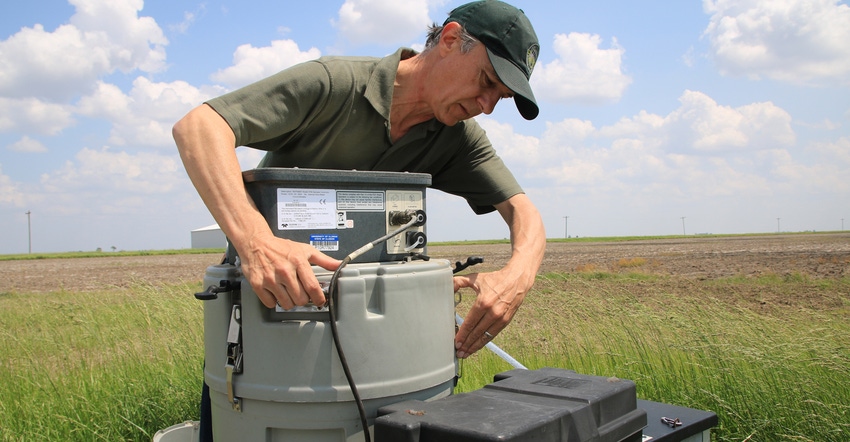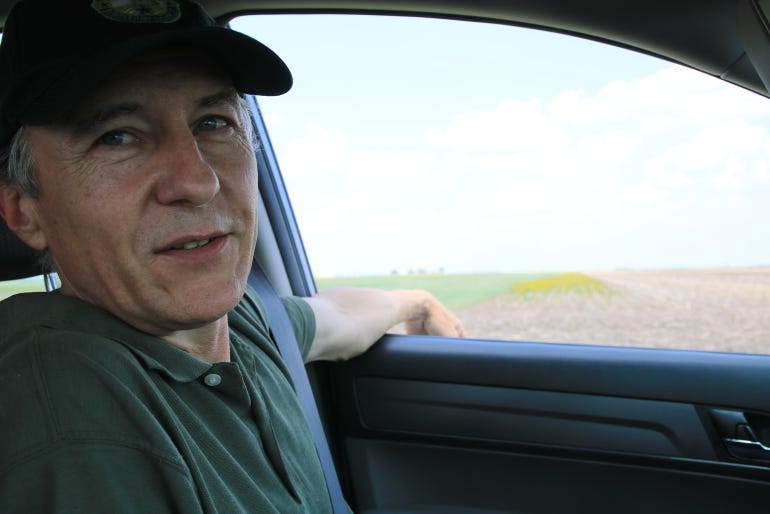
While it may not be happening yet in 2019, tile drainage lines moving water out of fields will eventually stop flowing, and when they do, river nitrate levels will decrease to less than 1 part per million, says Lowell Gentry, a University of Illinois scientist from the Department of Natural Resources and Environmental Sciences whose work is supported by the Nutrient Research and Education Council.
Gentry’s team has recorded data from the heavily drained, 85% row-cropped headwaters of the Upper Embarrass River at Camargo, Ill., since 1993 — the wettest year on record for the site and the only year when tile lines never stopped flowing into the river.
Based on this long-term river dataset, Gentry says the watershed loses an average of 27 pounds of nitrogen per acre per year in spite of periods of low nitrate loads during the summer and early fall months, when tiles are not draining.
“Illinois EPA has embarked on the idea of proposing a nutrient standard for water quality. And it would only be 4 ppm for nitrate; based on an annual flow-weighted mean nitrate concentration for streams and rivers, that’s what they’re thinking would protect local water quality,” Gentry says, adding the agency is reviewing public comments on the proposed policy.
“We have never seen a flow-weighted mean river nitrate concentration below 5.7 ppm in the past 25 years at Camargo, Ill.,” he says. “But do we have any farms that could get under 4 ppm now? Our [research] farm in Piatt County can, when you use a three-year rotation of corn-soybean-wheat.”
The tile-drained, no-till research site that was started in August 2014 features a unique rotation for central Illinois: corn, followed by the cover crop cereal rye; then soybeans; then winter wheat and a double crop of soybeans. Then the rotation starts over again with corn. Both corn and wheat received fertilizer N, while soybeans did not.
During the first year with corn at the site, researchers recorded an average of 7.7 ppm tile nitrate loss with a maximum return to yield-calculated N rate. But when cereal rye was growing ahead of soybeans, tile nitrate concentration was greatly reduced — with a steady decline in concentration through the spring season — averaging only 2.1 ppm in the second year of the study.
The winter wheat occupies the space of a cover crop and likewise helps hold nutrients in the field after soybeans are harvested, resulting in an average of 2.2 ppm tile nitrate concentration when normally it would be higher, Gentry says.
When it comes to nitrogen, much of the loss happens in the first rains after application on corn. However, N is also released during the nongrowing season through a process called mineralization, especially in recent soybean fields.
“The double-crop soybean after wheat led to a slight increase in tile nitrate concentration, but when we repeated again with corn, we’re down to 4.7 ppm in year 4 of the study. That three-point drop compared to year 1 tells you something’s working,” he says.
The three-year average tile nitrate concentration following year 1 of the experiment was 2.6 ppm. When year 1 is included, concentration still remains under 4 ppm, with a four-year average of 3.7 ppm.
Harvesting mineralization yields
In another no-till, tile-drained research plot near Filson, Ill., supported by the Foundation of Food and Agricultural Research, Gentry is looking at five different nitrogen fertilizer techniques, with a sixth enhanced by cover crops. Thirty-six tile laterals monitored on one farm allow him to repeat treatments and track nitrate loss for small groupings precisely.
He’s determined cereal rye can decrease tile nitrate loss after corn by 40% when applying a maximum return to N rate of 50% at planting and 50% sidedressed. His annual ryegrass stands died in the minus 20 degree F freeze this past winter ahead of planting corn, but the cereal rye planted in adjacent plots survived well.

OUTCOMPETING: Lowell Gentry says cereal rye outcompetes weeds in the narrow stands planted on tile drainage laterals in Filson, Ill.

While the annual ryegrass failed, the dead cereal rye biomass accumulated from a past growing season is carbon-rich and nitrogen-poor, just like corn stover. It has a beneficial effect that can be felt long after the cover dies off. Microbes eating the dead plants use residual soil nitrogen and hold on to it, increasing immobilization and limiting mineralization of nitrogen as they consume the residue.
The more carbon-rich the residue, the more nitrogen is potentially immobilized. Soybean biomass is carbon-poor and nitrogen-rich though, causing microbes to potentially break down soil organic carbon as they decompose residue if they don’t have living or dead carbon-rich biomass to turn to.
“We’ve got to have something intercepting nitrate that forms from mineralization in the nongrowing season, especially after soybeans,” Gentry concludes. “We tried oats and radish, but since they don’t overwinter, they didn’t cut it. Neither did annual rye grass. But while our Piatt County farmer harvests winter wheat, we’ll start using that crop here [on the Filson farm] as a cover because we know it survives minus 20 freezes. We’ll kill it ahead of corn planting like we would cereal rye.”
About the Author(s)
You May Also Like




